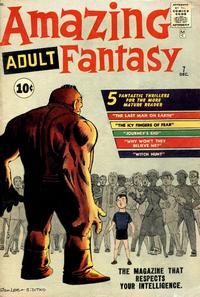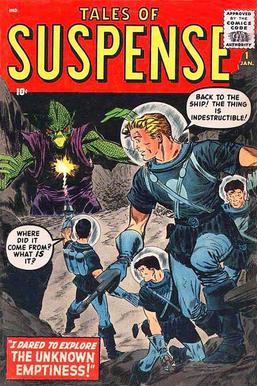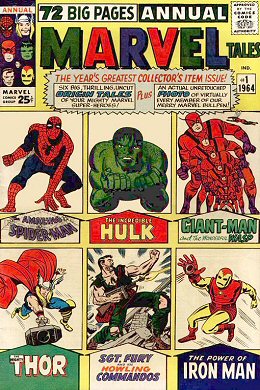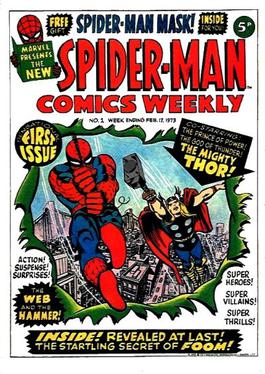
Marvel Comics is an American comic book publisher and the property of The Walt Disney Company since December 31, 2009, and a subsidiary of Disney Publishing Worldwide since March 2023. Marvel was founded in 1939 by Martin Goodman as Timely Comics, and by 1951 had generally become known as Atlas Comics. The Marvel era began in June 1961 with the launch of The Fantastic Four and other superhero titles created by Stan Lee, Jack Kirby, Steve Ditko, and many others. The Marvel brand, which had been used over the years and decades, was solidified as the company's primary brand.

Amazing Adult Fantasy, retitled Amazing Fantasy in its final issue, is an American comic book anthology series published by Marvel Comics from 1961 through 1962, with the latter title revived with superhero features in 1995 and in the 2000s. The final 1960s issue, Amazing Fantasy #15, introduced the popular Marvel superhero Spider-Man. Amazing Adult Fantasy premiered with issue #7, taking over the numbering from Amazing Adventures.

Timely Comics is the common name for the group of corporations that was the earliest comic book arm of American publisher Martin Goodman, and the entity that would evolve by the 1960s to become Marvel Comics.

Crazy Magazine is an illustrated satire and humor magazine that was published by Marvel Comics from 1973 to 1983 for a total of 94 regular issues. It was preceded by two standard-format comic books titled Crazy. The magazine's format followed in the tradition of Mad, Sick, Cracked and National Lampoon.

What If, sometimes stylized as What If…?, is a comic book anthology series published by Marvel Comics whose stories explore how the Marvel Universe might have unfolded if key moments in its history had not occurred as they did in mainstream continuity. Since What If debuted in 1977, the comics have been published in 14 series as well as occasional stand-alone issues. In 2024, Marvel announced that What If…? would expand to include alternate explorations of continuity within other non-Marvel Universe properties owned by their parent company The Walt Disney Company from its fifteenth volume onwards, beginning with Aliens: What If…?, based on the Alien franchise.

Tales of Suspense is the name of an American comic book anthology series, and two one-shot comics, all published by Marvel Comics. The first, which ran from 1959 to 1968, began as a science-fiction anthology that served as a showcase for such artists as Jack Kirby, Steve Ditko, and Don Heck, then featured superheroes Captain America and Iron Man during the Silver Age of Comic Books before changing its title to Captain America with issue #100. Its sister title was Tales to Astonish. Following the launch of Marvel Legacy in 2017, Tales of Suspense was once again resurrected at issue #100, featuring the Winter Soldier and Hawkeye in a story called "The Red Ledger".
Amazing Adventures is the name of several anthology comic book series, all but one published by Marvel Comics.

Sgt. Fury and his Howling Commandos is a comic book series created by Jack Kirby and Stan Lee and published by Marvel Comics from 1963 to 1981. The main character, Sgt. Nick Fury, later became the leader of Marvel's super-spy agency, S.H.I.E.L.D. The title also featured the Howling Commandos, a fictional World War II unit that first appeared in Sgt. Fury and his Howling Commandos #1.
Arnold Drake was an American comic book writer and screenwriter best known for co-creating the DC Comics characters Deadman and the Doom Patrol, and the Marvel Comics characters the Guardians of the Galaxy, among others.

Atlas Comics was the 1950s comic-book publishing label that evolved into Marvel Comics. Magazine and paperback novel publisher Martin Goodman, whose business strategy involved having a multitude of corporate entities, used Atlas as the umbrella name for his comic-book division during this time. Atlas evolved out of Goodman's 1940s comic-book division, Timely Comics, and was located on the 14th floor of the Empire State Building. This company is distinct from the 1970s comic-book company, also founded by Goodman, that is known as Atlas/Seaboard Comics.

What The--?! is a Marvel Comics comic book series self-parodying the Marvel Universe, similar in vein to the 1960s series Not Brand Echh. It was billed as "The Marvel mag of mirth and mayhem!" The series ran for 26 issues, from August 1988 through Winter 1993, with issue #26 being a Fall Special. It typically contained a series of short stories with comedic takes on Marvel heroes and villains, such as having Spider-Ham substitute for Spider-Man.
Forbush Man is a character appearing in American comic books published by Marvel Comics. Originally the mascot of Marvel's Not Brand Echh, he is the alter-ego of Irving Forbush, a fictional employee of "Marble Comics". Forbush was devised in 1955 by Marvel editor Stan Lee to refer to an imaginary low-grade colleague who was often the butt of Lee's jokes. In his guise of Forbush-Man, he first appeared in 1967.
The Witness is the name of at least three fictional characters appearing in American comic books published by Marvel Comics. Of these, the first was published by Timely Comics in the 1940s and the final two by its successor company, Marvel Comics.

Marvel Tales is the title of an American comic book series published by Marvel Comics from 1964 to 1994 and a flip magazine series published Marvel Comics by from August 2005 to February 2007. Both series primarily reprinted Spider-Man stories.

World of Fantasy was a science fiction/fantasy comic book anthology series published by Marvel Comics' 1950s predecessor company, Atlas Comics. Lasting from 1956 to 1959, it included the work of several notable comics artists, including industry legends Jack Kirby, Steve Ditko, and Bill Everett.
Mystic Comics is the name of three comic book series published by the company that eventually became Marvel Comics. The first two series were superhero anthologies published by Marvel's 1930-1940s predecessor, Timely Comics, during what fans and historians call the Golden Age of comic books. The third, simply titled Mystic, was a horror fiction-suspense anthology from Marvel's 1950s forerunner, Atlas Comics.

Marvel Age was a promotional comic book-sized magazine from Marvel Comics published from 1983 to 1994. Basically a comic-length edition of the Bullpen Bulletins page, Marvel Age contained previews of upcoming Marvel comics, as well as interviews with comics professionals and other features, including occasional original comic strips. It is also notable for early work by Marvel writers such as Peter David and Kurt Busiek.

Space Adventures was an American science-fiction anthology comic book series published sporadically by Charlton Comics from 1952 to 1979. Its initial iteration included some of the earliest work of industry notables Steve Ditko, Dick Giordano, and Tony Tallarico, and at least one story by EC Comics mainstay Bernard Krigstein.

Spider-Man Comics Weekly was a Marvel UK publication which primarily published black-and-white reprints of American Marvel four-color Spider-Man stories. Marvel UK's second-ever title, Spider-Man Comics Weekly debuted in 1973, initially publishing "classic" 1960s Spider-Man stories.
Snafu is a short-lived satirical comic book published by Marvel Comics in the mid-1950s. One notable contribution of Snafu is that it introduced the character Irving Forbush, the alter ego of Forbush Man. Snafu was an attempt to duplicate the success of Mad magazine, which had much greater success and longevity.














